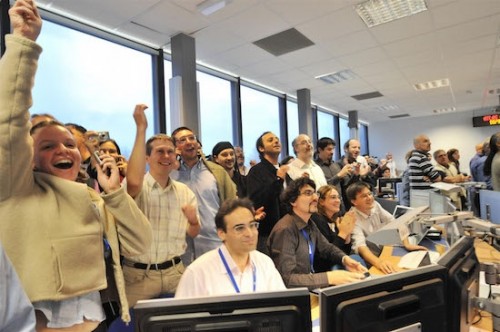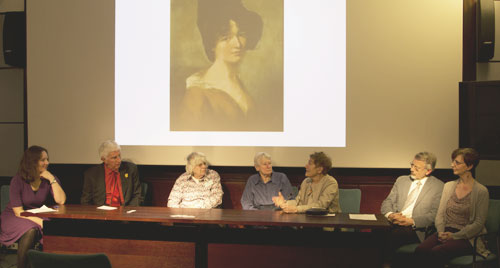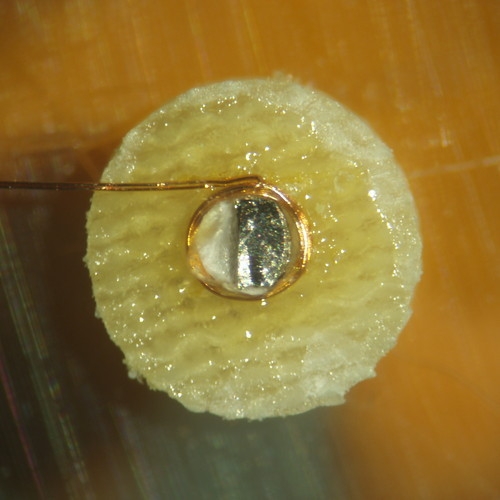Tag archives: women in physics
The August 2015 issue of Physics World is now out
By Matin Durrani
Mention the two words “science policy” and most physicists’ eyes will probably glaze over. Most of us dream of discovering a new planet or finding the Higgs boson – not poring over budget spreadsheets, championing science to politicians or commenting on legislation.
But science policy is vital in today’s world, which depends hugely on scientific research and in the cover feature of the August issue of Physics World, which is now out, Len Fisher and John Tesh offer 12 practical tips for scientists who want their ideas incorporated into science policy. You’ll be intrigued by what the two authors have to say.
Elsewhere in the issue, as my colleague Tushna Commissariat explains in the video above, there’s a great feature based on an interview with the French physicist Hélène Langevin-Joliot – the granddaughter of Marie Curie. In the article, Langevin-Joliot explains what’s known as the “Curie complex” and gives her own tips for scientific success. Langevin-Joliot didn’t suffer from the complex herself, but she acknowledges that it is a big problem for others and, these days, spends her time actively promoting careers for women in science
Success, failure and women in physics
By Margaret Harris
Giving out science careers advice is tricky. On the one hand, you want to be encouraging – not least because if you aren’t, there is a chance that your advisee will go on to win a Nobel prize, and you will then look extremely silly. But on the other hand, you also want to prepare the person, mentally, for the possibility of failure. Otherwise, when they do fall short, they may not know how to recover and try again.
The need for balance between encouraging big dreams and preparing for failure was one of the central insights to come out of Sunday’s panel on “Feminism, sexism and bringing up girls” at the Cheltenham Science Festival. After one of the panel members, psychologist Tanya Byron, noted that in clinical practice she sees many bright, successful girls whose fear of failure is “absolutely destroying them”, her fellow panellist Gabriel Weston put her finger on the heart of the problem. How, Weston asked, do we celebrate young women’s achievements and encourage their dreams without also pushing them to be “perfect little glass statues” who shatter under pressure?
View all posts by this author | View this author's profile
Pioneering women of physics, why you should become a particle physicist and a BICEP2 scientist on all that dust

Smiley happy people: who would not want to be a particle physicist? (Courtesy: ATLAS)
By Hamish Johnston
Over on the Quantum Diaries blog, Aidan Randle-Conde has put together a lovely photo-essay called “30 reasons why you shouldn’t be a particle physicist”. It is reverse psychology, of course, and the 30 images highlight the benefits of devoting your life to studying sub-atomic particles. As someone who chose to do condensed-matter physics, do I now think that I made a huge mistake? No, but I have shared the thrill and excitement of being at CERN when the Higg’s was discovered and seen the Large Hadron Collider and its detectors up close, so I know where he is coming from.
View all posts by this author | View this author's profile
Rediscovering Marie Curie and the pioneering women of science

The panel of speakers at the women in physics conference. (Courtesy: Institute of Physics)
By Tushna Commissariat
This Sunday, as the world celebrates International Women’s Day, I’ll be thinking of some amazing women who had a huge impact on the world of physics, helping shape the field as we know it today. Indeed, yesterday I was at the Institute of Physics in London, attending a day-long conference on “The lives and times of pioneering women in physics” hosted by the Institute’s Women in Physics group along with its History of Physics group. While there were a host of interesting speakers at the event, undoubtedly the star of the day was French nuclear physicist Hélène Langevin-Joliot, granddaughter of one of the 20th-century’s most famous female physicists – Marie Curie.
Candy corn in space, compact fusion reactors and physics in Palestine
By Hamish Johnston
Besides the great views of the Earth, one of the best things about being on the International Space Station (ISS) must be messing around in near-zero gravity. In the above video on Science Friday the American astronaut Don Pettit describes an “experiment” that he did on the ISS using candy corn, which are kernel-like sweets. He begins with a blob of floating water into which he inserts the candy corn pointy-end first. The points are hydrophilic so they tend to stay in the water, and eventually Pettit has a sphere of candy corn packed around the water. The flat ends of the candy corn have been soaked in oil to make them hydrophobic so the candy corn layer acts like a detergent film or one half of a cell membrane. It’s a fun video and I wonder how he got the idea in the first place?
View all posts by this author | View this author's profile
A theremin fit for a gerbil, hairdos for physicists and the trouble with Richard Feynman

Calling all musical gerbils: a new take on the theremin. (Courtesy: Paul Goddard)
By Hamish Johnston
“How we created spooky experimental music in a superconductor lab”: what physicist could resist clicking on this story, which appeared on the Guardian website earlier this week? Written by the physicist-turned-computational-biologist Andrew Steele, the article describes how Steele and a few pals converted a magnetic sensor into a musical instrument. Like the theremin, which is played by waving your hands around an antenna, this new instrument responds to the player’s motion. But because the sensor was optimized for studying superconductors rather than creating freaky mood music, Steele explains the “instrument covered three octaves in less than a centimetre of hand movement”. He suggests that playing the instrument should probably be left to a talented gerbil rather than talented superconductor researchers. You can listen to Steele’s attempt at making music on SoundCloud.
The cost of stereotypes
By Margaret Harris
When a 2012 study showed that scientists subconsciously favour male students over females when assessing their employability as early-career researchers, it generated plenty of debate – not least among women, who were, according to the study, just as likely to be biased as the men were.
Some of these discussions got rather overheated, but one cogent criticism of the study did emerge. Roughly, it was this: might the scientists’ preference for men over equally well-qualified women be a rational response to the fact that, because of various barriers, women in science often need to be better than their male counterparts in order to have an equal chance of success?
The question was an awkward one, since it implied that women in science could be caught in a vicious circle, with the negative effects of bias in the workplace making it “rational” to be biased in hiring (and, in turn, making such workplace bias more likely to persist). However, a new study appears to rule out this argument by finding similar patterns of hiring bias against women even when the “job” is an arithmetical task that, on average, women and men perform equally well.
View all posts by this author | View this author's profile
Lateral Thoughts: a foreign country
By Margaret Harris

“The past is a foreign country; they do things differently there.”
I’ve been re-learning this lesson recently thanks to “Lateral Thoughts”, the column of humorous, off-beat or otherwise “lateral” essays that appears on the back page of Physics World each month. These articles are written by our readers and they have been part of the magazine ever since it was launched in October 1988. In fact, Lateral Thoughts is the only section of Physics World that has remained unaltered in its 25-year history.
Unaltered in its format, that is. But what about the actual content of the essays? Lateral Thoughts are not normally commissioned by members of the editorial team; instead, they’re selected from a pool of submissions sent in, unsolicited, by Physics World readers. Any shifts in style or subject matter should, therefore, tell us something about the way that the physics community has evolved over the years.
With this in mind, I began trawling through the archive of past Lateral Thoughts, looking for evidence of change. And boy, did I ever find it.
3D printing, Ada Lovelace and controversial bloggers
By James Dacey
One of the more inspiring stories we have come across this week was the tale of a resourceful inventor in the West African nation of Togo. Kodjo Afate Gnikou has managed to build a 3D printer at the meagre cost of $100 by mainly using parts he found in a scrap yard in the capital city Lomé. The story is described on inhabitat.com, which says the machine has been constructed from broken scanners, computers, printers and other e-waste.
On the subject of 3D printing, Wired magazine ran a story about how the UK supermarket chain Asda is planning to trial a 3D printing service at its store in York. They will be offering customers the chance to take a break from their shopping to have a full body scan, which will be used to create miniature dolls of themselves. Prices apparently start at £40 and Asda boasts about how lifelike these dolls can be: “The technology produces highly realistic ‘mini me’ figurines at whatever scale you like!”

Portrait of Ada Lovelace (1838)
From a shop in York to the next story that involved celebrations all round the world. Tuesday was Ada Lovelace Day 2013. The annual celebrations, which are now in their fifth year, are held to recognize the achievements of women in science, technology, engineering and maths (STEM). The annual event was founded in 2009 by the social technologist and writer Suw Charman-Anderson “as a response to online discussions about the lack of women on stage at tech conferences”.
This year events included a mass Wikipedia “editathon” at the University of Oxford in an attempt to raise the profile of women’s contributions to science, as described in this article in the Guardian.
View all posts by this author | View this author's profile
Celebrating Ada Lovelace Day 2013
By James Dacey

Portrait of Ada Lovelace (1838)
Science songs in London and a series of “lightning talks” in the Equadorian capital Quito are among the many events being held today around the world to mark Ada Lovelace Day 2013. The annual celebrations, which are now in their fifth year, are held to recognize the achievements of women in science, technology, engineering and maths (STEM).
The day’s namesake Ada Lovelace is often referred to as the world’s first computer programmer. Born in 1815, Lovelace was a child of the Romantic poet Lord Byron, and was raised by her mother who encouraged her daughter to develop an interest in science, logic and mathematics. Lovelace excelled and became friends with the mathematician Charles Babbage at the University of Cambridge, who had already started drawing up plans for his famous calculating machines.
View all posts by this author | View this author's profile
